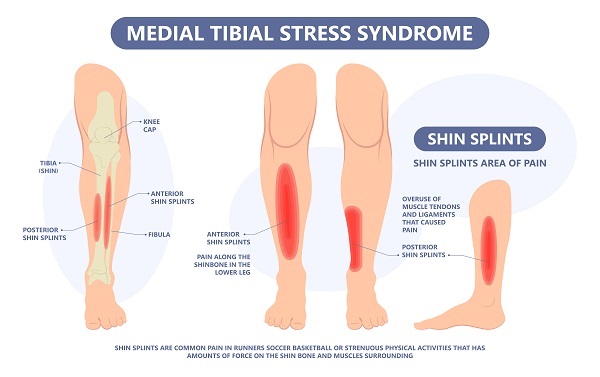
Why Do Runners Get Shin Splints?
1 CommentIf you’ve ever felt a nagging pain or tingling along the inside of your shinbone (tibia), you may have what’s known as shin splints. The good news is with proper recovery and tips from your physical therapist; this injury doesn’t have to keep you from doing what you love. Read below to learn more about shin splints and how they’re treated.
What Are Shin Splints?
Shin splints, or medial tibial stress syndrome (MTSS), is a common injury that sidelines runners. Although the exact cause of pain is relatively unknown, recent research suggests that the pain is related to a stress reaction to the tibia, or shinbone.1 This causes pain that is felt on the inside part of your shinbone and can be tender to the touch.

What Causes Shin Splints?
Training errors are one of the most common ways runners get injured. Did you suddenly increase the number of miles you ran this week? Did you suddenly increase your intensity or number of runs per week? Ramping up your exercise intensity too quickly can result in injury. Biomechanically, MTSS is most likely caused by excessive pronation of the foot, or, in other words, poor ankle/foot stability and arch strength. Sometimes, poorly fitted shoes or shoes with inadequate arch support can allow for the development of MTSS.
How is it Treated?
If you are dealing with MTSS symptoms, it might be best to take some time off from running to allow the stressed area of bone to heal. Severe cases of MTSS may lead to tibial stress fracture, which prolongs and complicates recovery. Instead, try cutting down your time spent running each week by 50%, and run at this volume until your pain subsides. If this isn’t effective, replace running with an elliptical or biking to maintain cardiovascular fitness until symptoms subside.
How Can a Physical Therapist Help?
Additionally, a physical therapist or exercise professional should be consulted to determine whether your footwear fits you appropriately. Either can help you decide whether you need shoes that fit better or provide you with more arch support.
A skilled physical therapist can even perform a running analysis to see if you have any flaws with your running technique that might lead to injuries such as muscular weakness, stability problems, or flexibility issues.
Don’t Put Off Your Pain
If you are dealing with pain interfering with your running, get started with a Free Assessment at an Athletico clinic near you. There, one of our skilled clinicians can help you determine what’s causing your pain and make recommendations to get you on the path to recovery and across the finish line. Free Assessments are available in-clinic and virtually through our Telehealth service.
The Athletico blog is an educational resource written by Athletico employees. Athletico bloggers are licensed professionals who abide by the code of ethics outlined by their respective professional associations. The content published in blog posts represents the opinion of the individual author based on their expertise and experience. The content provided in this blog is for informational purposes only, does not constitute medical advice and should not be relied on for making personal health decisions.
References:
1. Reshef N, Guelich DR. Medial tibial stress syndrome. Clin Sports Med. 2012 Apr;31(2):273-90. doi: 10.1016/j.csm.2011.09.008. PMID: 22341017.

1 Comment
Vivian Black
I love that a physical therapist can help you to choose footwear when it comes to running shoes. I have been a serious runner for five years. Recently I suspect that I have acquired shin splints. Seeing a physical therapist is first on my list of how to deal with this.